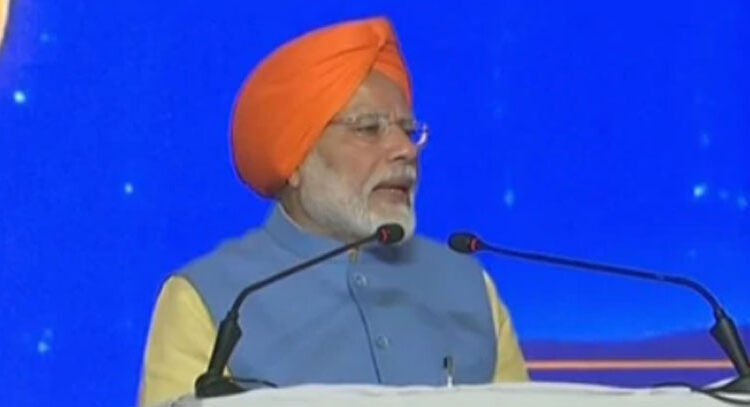
A corridor of hope: Will historic India–Pakistan pilgrim initiative bring harmony to South Asia?
This story first appeared in South Asia Monitor
The inauguration of Kartarpur corridor between India and Pakistan, a pilgrim initiative has given rise to many positive political ideas in these two countries. Senior journalist and SAWM member Nilova Roy Chowdhury writes about how it also generates hope for harmony across South Asia.
A ray of warmth cut through the icy-cold relations between India and Pakistan when a bilateral initiative, putting differences aside to commemorate the 550th birth anniversary of Guru Nanak, the first Sikh guru and founder of the Sikh faith, and build a pathway to facilitate the passage of pilgrims across the river Ravi to a shrine in Pakistan particularly sacred to the Sikh community, came into being on November 9.
While the choice of the date for the inaugural of the Kartarpur Corridor is probably related entirely to the timing of Guru Nanak’s birth anniversary, there is, nevertheless, considerable significance in November 9, 2019, being chosen. It is exactly 30 years since the fall of the Berlin Wall, which ended the Cold War and brought German unification. While unification between India and Pakistan is rather far-fetched, could there be a subtle significance in the choice of this particular date?
Indian Prime Minister Narendra Modi flagged off the first ‘jatha’, or a band of around 550 pilgrims, including former Prime Minister Manmohan Singh, Union Ministers Harsimrat Kaur and Hardeep Singh Puri and Punjab Chief Minister Amarinder Singh, from the newly-built passenger terminal and integrated checkpost on the Indian side of the India-Pakistan border on Saturday.
The 4.5 km pathway, known as the Kartarpur Corridor, which connects the Dera Baba Nanak shrine in Indian Punjab with the Darbar Sahib or Kartarpur Sahib gurudwara in Narowal district in Pakistan’s Punjab, was thrown open in the afternoon facilitating the movement of the first batch of pilgrims to travel to the last resting place of Guru Nanak.
Thanking all those who have been associated with the project, Modi particularly thanked Pakistan Prime Minister Imran Khan for “understanding Indian sentiments” and for cooperating with his government to complete the project in time for the anniversary.
“After the construction of this corridor, Gurudwara Darbar Sahib (in Kartarpur, Pakistan) will become easily accessible to Sikh pilgrims,” Modi said during the opening.
Congratulating the Sikh community on the inaugural of the Corridor, to coincide with the 550th birth anniversary of Baba Nanak, as he is known in Pakistan, Prime Minister Khan welcomed the Sikh pilgrims on Pakistani soil and said the opening of the historic Kartarpur Sahib Corridor is testimony to Pakistan’s commitment to regional peace.
On the Indian side, the celebrations surrounding the inauguration of the Corridor were muted by the massive public and media attention surrounding the landmark judgement on the Ayodhya dispute delivered by a Constitution Bench of the Supreme Court Saturday.
The inauguration of the historic Kartarpur Corridor, a people-to-people initiative first mooted in 1999 during the historic bus visit to Lahore undertaken by former Prime Minister Atal Bihari Vajpayee, sparks a glimmer of hope in the otherwise extremely bleak bilateral India-Pakistan relationship.
At the popular level, it restores a link, ruptured during the Partition of India and creation of Pakistan, between all the communities, but here between shrines sacred to the Sikh community, by allowing visa-free passage between the two countries for pilgrims wishing to visit the Kartarpur shrine.
Although India and Pakistan signed a Protocol on Visits to Religious Shrines in 1974, the bilateral agreement facilitated the visit by nationals of both countries to just some religious shrines in both countries. As of November 2018, 15 locations in Pakistan and five in India are covered under this protocol, which did not include Kartarpur, causing considerable distress to the Sikh community in particular. As the place where Guru Nanak spent the last 18 years of his life and died, the site is particularly sacred.
In the current “zero-sum” relationship between India and Pakistan, New Delhi is deeply concerned that Islamabad will try to exploit this Corridor to revive Sikh militancy and terrorism in Indian Punjab, which had largely disappeared by the early 1990s. In fact, Pakistan’s attempts to include some known advocates of Sikh separatism during the Kartarpur Corridor negotiations had almost stalled the project.
It remains to be seen if this Corridor foments further discord or, by allowing easy access, facilitates a measure of understanding between the people on both sides, thus putting some pressure on the two governments to resume talking to each other. If the project works as a successful confidence-building measure and helps to revive some kind of dialogue between South Asia’s two largest neighbours, then the first guru of Sikhism, as many have hoped, would have worked his magic to rebuild an element of harmony in the bitter standoff between the two countries.
There is already some talk that the two governments would fully restore diplomatic relations early in the new year and send their High Commissioners to assume their posts in Islamabad and Delhi. But, for India, all that is predicated on a cessation of terrorist activity inspired and abetted from across the border.
